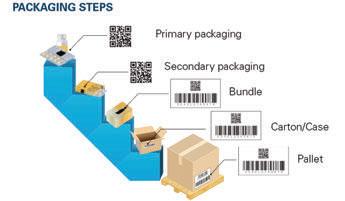
10 minute read
TRACEABILITY
Pharma Supply Chain: Master Data Exchange in 2021
KEREN SOOKNE, DIRECTOR OF EDITORIAL CONTENT
1. The global GS1 standard, EPCIS, offers a common information exchange language. 2. EPCIS onboarding takes time and requires immediate action from pharma manufacturers. 3. To avoid product holdups, it’s critical that manufacturers have processes in place for exceptions in data exchange.
TOP THREE TAKEAWAYS
In order to arrive at the unit-level traceability sought by the Drug Supply Chain Security Act (DSCSA) by its 2023 deadline, the pharmaceutical industry as a whole must tackle the issue of interoperable systems to share data with trading partners.
The overall goal of DSCSA legislation is to verify product legitimacy, make recalls more effi cient, and enhance detection of illegitimate products in the supply chain. A major component of this is the requirement of serialization, the practice of assigning a unique serial number linked to product data—product origin, batch number, and expiration date—to each saleable unit of each prescription drug product.
“But the exchange of master data today is a manual process,” explained Allison Sheldon, Senior Manager, Pfi zer Digital Serialization, Pfi zer Inc. at a recent Healthcare Distribution Alliance (HDA) Traceability Webinar event. Serialization data is manually pulled from internal systems, and spreadsheets are maintained and emailed back and forth to trading partners.
Part of what manufacturers are trying to sort out now is how their trading partners are managing data on their end. “Are they taking HDA’s forms and applying changes that are required in their systems? How do we keep that data up to date? We’ll see that
↑ Get the links the panelists offered at hcpgo.to/gs1. (Credit: HDA)
Related Stories at HealthcarePackaging.com
+ Serialization 101 Fraud is a serious issue for drug manufacturing, and pharmaceutical and medical device regulations using serialization have been mandated to defend against counterfeiting. hcpgo.to/s101 + [Video] MIT PhD on Supply Chain Resiliency in the Face of COVID-19 MIT’s Dr. David
Simchi-Levi visited with Keren Sookne, Healthcare Packaging, to re-examine how life science companies think about their supply chains. hcpgo.to/resilience + 3 EPCIS Data Exchange Issues in Pharma Traceability Conformance testing services emerged to cut down on wasted back-and-forth between manufacturers and trading partners to get effi cient data exchange up and running. hcpgo.to/3epcis + The Logistics of Supply Chain Visibility Tive and project44 team up to deliver the
Open Visibility Network, a way to provide transparency between shippers, logistics service providers, brokers, and customers. hcpgo.to/visibility
when there’s any type of mismatch, that creates failures when we’re exchanging our serialized data. It’s certainly not sustainable—we need to come to an automated approach,” said Sheldon.
Brad Pine, Vice President, Brand Pharma & Regulatory at Smith Drug Company, Div. J M Smith Corporation, agreed. “Everybody gets HDA spreadsheets and adds the GTIN [Global Trade Identification Number]—it’s still not very well-adopted. You’re constantly sending them back to manufacturers and saying, ‘You didn’t have the GTIN on here.’ Then loading information from a spreadsheet is painstaking and it’s prone to errors because of the formatting. If I don’t capture lead zeros correctly, there are issues with that.”
EPCIS onboarding
The answer, panelists said, lies in pharma manufacturers using a common framework to exchange data: EPCIS (Electronic Product Code Information Services) fi les.
EPCIS is a global GS1 standard for creating and sharing visibility event data, both within and across enterprises, to enable users to gain a shared view of physical (or digital) objects. Physical objects include products, logistics units, documents, and more, while digital objects can refer to items such as music downloads, e-books, and e-coupons.
Adoption is off to a rocky start. “Our biggest challenge is fi nding manufacturers that are willing to send us EPCIS events and get that onboarded,” said Pine. In a best-case scenario, Sheldon off ered a chart showing that it takes around six weeks to onboard between manufacturer and distributor, covering three main activities: • Exchanging master data • Testing • Moving into production
The six weeks represents a “happy path” where everyone is talking consistently and maintaining momentum. It involves a variety of stakeholders between the trading partner and internal personnel from marketing, IT, logistics, and warehouse operations. “And this could be for just one trade partner. So keep that in mind as we look at the volume of onboarding work that we need to do over the
next year and a half or so,” advised Sheldon.
Challenges
Working with wholesale distributor or dispenser partners, pharma manufacturers are running into a number of issues once they are testing or live in production. There are errors in master data files that cause failures, or a trade partner didn’t have a particular GTIN—possibly due to scanning an “inner pack.”
Following standards is key. There may be timestamp issues in a file, and as Sheldon pointed out, it’s one thing to determine the file failed because of a timestamp issue, “but then from the manufacturer side, we need to go back and look at, ‘Why was there a timestamp issue?’ and then you might uncover other process changes that need to happen to address that going forward. As I’m sure everyone knows, process changes don’t happen overnight.”
Pine echoed the need to follow standards and start soon. “You find that there’s a lot of syntax errors and aspects that are glitchy. When you talk to the bigger manufacturers, they are certainly in test phases with the big three—a few of them are testing with us—but the big three are definitely pushing the issue. It’s really important that we start testing and putting together production as soon as possible, because there’s a lot to be done before November 2023,” he said.
Jeff Falardeau, Manager, Pharmaceutical Information Technology at Cardinal Health, Inc., said that in working with their manufacturing partners, another challenge is readiness. “Communication is another area where time could be compressed. We might get a test file and we’ll respond usually within a business day. But we don’t know what happens once we send that response out—it may go into some kind of rework and come back. I’m not sure how closely mailboxes are monitored, but there’s an awful lot of time lost just in exchanging messages back and forth,” Falardeau said. “Proficiency is all over the place. Some companies are very proficient, some are less so. That leads to situations where we might get chronology errors with the EPCIS event times—probably the largest source of errors that we get. We might be missing master data altogether, missing master data elements, or have extra master data inserted where it doesn’t belong. Quite a wide variety of things.”
Michael Ventura, Vice President, Solutions & Innovations at LSPediA, noted that everybody should be working with their solution providers to be up and running on EPCIS version 1.2 and testing with their supply chain partner.
Lower volume manufacturers
EPCIS-formatted messages are usually generated through L4 enterprise systems. But there are options for generating EPCIS messages for low volume or low frequency shipments to avoid the additional costs related to new L4 modules. Falardeau explained that for those who don’t have an internal IT group that can extract information and formulate EPCIS files, there are solution providers that will take data in most any form and convert it.
3PL vs. manufacturer responsibilities
Audience members were curious if manufacturers will need to have all their distributors or wholesalers onboarded to their serialization system to track transaction information directly, or whether their 3PL can send that information if they have it. Pine explained, “If you read the law, the law just says that the manufacturer has to
Also in Traceability News
+ HDA, in coordination with the Center for Supply Chain Studies, announced the successful conclusion of an industry-wide pilot of an interoperable “authorized trading partner” credentialing ecosystem to support DSCSA requirements in March 2021. Stakeholders who intend to adopt this model have launched the Open Credentialing Initiative (OCI), a user group that will publish frameworks, address recommendations, work on standardizing artifacts, and explore other use cases. + Cardinal Health is one of many distributors working to strengthen collaboration with industry and government to transform the supply chain. For PPE and other critical COVID19 products, Cardinal began working with freight-tracking software startup FourKites in March 2020 to gain better visibility into its delivery network and maximize provider access to much-needed products. They collaborated on a pilot program to track shipments of PPE, and built a customized system to track temperature-sensitive medical products, now used in all Cardinal Health transport modes throughout the U.S. Up next: supply chain solutions for the
“last mile” of delivery. More info: hcpgo.to/covid-supply + Traceability is key to ensuring safe and equitable vaccine distribution. Antares Vision Group has designed and installed systems that combine visual inspection and serialization on vial filling lines for several companies. The latest system is equipped with technologies to allow accurate visual inspection for liquids and/or lyophilized products,
Container Closure Integrity Testing, and, in integrated mode, the serialization of single doses. This includes in-line printing and control of a data matrix code with visible or UV-visible ink to share information with health authorities, and throughout the supply chain. This is of particular importance with the use of lyophilized products expected to be adopted in the production of COVID-19 vaccines soon.
send the information to us [a distributor]. So that’s descriptive in who’s going to be sending it to me. But I’m just as happy to get data from the 3PLs as I am from the manufacturer. I think each manufacturer is thinking that through a little bit diff erently. Some of them want to have control and others are happy with allowing their 3PL to do the work for them.”
Just don’t forget that while a 3PL facilitates many activities on behalf of the manufacturer, when an FDA auditor comes in and asks for information, the manufacturer is ultimately responsible.
Verifi cation router service
When Pine’s company surveyed manufacturers about whether they would be using a verifi cation router service (VRS) system for the DSCSA’s saleable returns verifi cation requirement, many mentioned they wanted to use EPCIS fi les instead. “A lot of them
↗ Data is generated at every level of packaging. were using 3PLs. I think that they’re thinking that they can get around the VRS by using EPCIS, and in a lot of events, that’s probably going to be true. But VRS is the only viable thing that we can think of for really verifying products upon return when we don’t have the EPCIS events,” said Pine.

Closing advice
The main point panelists hammered home is (1) to ensure you have processes (resources, tools, and SOPs) for exception management and (2) to get help with data exchange as soon as possible if you need it. “Full and timely adoption for exchange with manufacturers and distributors is key. Risk and impacts are very high and extreme if we can’t ship product for which we don’t have the data. So when fi les come in, if they fail, we need to react quickly,” said Falardeau. “Cardinal Health looks to invest in automation to help with that, to work with manufacturers, and to reduce that turnaround time. But as I alluded to earlier, there’s a wide range of profi ciency levels right now. Manufacturers, if they’re not already, really need to start pulling themselves in here to get up to speed more quickly or seek help from solution providers. We also highly recommend conformance testing companies that will help you learn EPCIS or help you be able to test rapidly. For now, we’re just really concerned about the runway left and the number of manufacturers that still need to jump in the pool and start testing with us before 2023.”
Manufacturing software that helps you change the world one product at a time

Your heart is in every product you manufacture, and it shows.

DELMIA|Works’ ERP and MES software provides the platform for you to focus on your customers, and in doing so changing the world with every product you ship.











